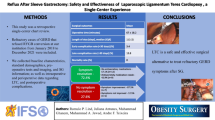Abstract
INTRODUCTION: Surgeons have been reluctant to apply laparoscopic techniques to Crohn's disease surgery because of concerns with evaluating and excising inflamed tissue using laparoscopic methods Additionally in Crohn's disease surgery, laparoscopic techniques have not been demonstrated to have clear advantages over conventional ones. METHOD: We conducted a prospective, randomized trial in one surgical department comparing laparoscopic vs. conventional techniques in 60 patients (25 males), median age 34.4 (range 10–60.1) years, undergoing elective ileocolic resection for refractory Crohn's disease. Postoperatively, all patients underwent measurement of pulomnary function tests every 12 hours, and were treated identically on a highly controlled protocol with regard to analgesic administration, feeding, and postoperative care. RESULTS: Of the 31 patients assigned to laparoscopic and 29 to the conventional group, all had isolated Crohn's disease of the terminal ileum plus or minus the cecum. Median length of the incision was 5 cm in the laparoscopic group and 12 cm in the conventional group. Overall recovery of 80 percent of forced expiratory volume (one second) and forcec vital capacity was a median of 2.5 days for laparoscopic and 3.5 days for conventional (P=0.03). There was no difference in the amount of morphine equivalents used between groups postoperatively. Flatus and first bowel movement returned a median of 3 and 4 days, respectively, after conventional roscopicvs. 3.3 and 4 days, respectively, after conventional surgery (P=0.21). Median length of stay was five (range, 4–30) days for laparoscopic, and six (range, 4–18) days for conventional surgery. Major complications occurred in one patient in each group. Minor complications occurred in four laparoscopic and eight conventional patients (P<0.05). There were no deaths. Two laparoscopic patients were converted to conventional as a result of adhesions or inflammation. All patients recovered well and there were no clinical resurrences in the follow-up period (median, 20; range, 12–45 months). CONCLUSIONS: Within a single insititution, single surgical team, prospective, randomized trial, laparoscopic techniques offered a faster recovery of pulomary function, fewer complications, and shorter length of stay compared with conventional surgery for selected patients undergoing ileocolic resection for Crohn's disease.
Similar content being viewed by others
References
Bauer JJ, Harris MT, Grumbach NM, Gorfine SR. Laparoscopic-assisted intestinal resection for Crohn's disease. Which patients are good candidates? J Clin Gastroenterol 1996;23:44–6.
Ludwig KA, Milsom JW, Church JM, Fazio VW. Preliminary experience with laparoscopic intestinal surgery for Crohn's disease. Am J Surg 1996;171:52–5.
Wu JS, Birnbaum EH, Kodner IJ, Fry RD, Read TE, Fleshman JW. Laparoscopic-assisted ileocolic resections in patients with Crohn's disease: are abscesses, phlegmons, or recurrent disease contraindications? Surgery 1997;122:682–9.
Lui CD, Rolandelli R, Ashley SW, Evans B, Shin M, McFadden DW. Laparoscopic surgery for inflammatory bowel disease. Am Surg 1995;61:1054–6.
Reissman P, Salky BA, Pfeifer J, Edye M, Jagelman DG, Wexner SD. Laparoscopic surgery in the management of inflammatory bowel disease. Am J Surg 1996;171:47–51.
Ogunbiyi OA, Fleshman JW. Place of laparoscopic surgery in Crohn's disease. Baillieres Clin Gastroenterol 1998;12:157–65.
Böhm B, Milsom JW, Kitago K,et al. Use of laparoscopic techniques in oncologic right colectomy in a canine model. Ann Surg Oncol 1995;2:6–13.
Decanini C, Milsom JW, Böhm B, Fazio VW. Laparoscopic oncologic abdominoperineal resection. Dis Colon Rectum 1994;37:552–8.
Milsom JW, Böhm B, Decanini C,et al. Laparoscopic oncologic proctosigmoidectomy with low colorectal anastomosis in a cadaver model. Surg Endosc 1994;8:1117–23.
Hildebrandt U, Schiedeck T, Kreissler Haag D,et al. Laparoscopically assisted surgery in Crohn's disease. Zentralbl Chir 1998;123:357–61.
Halpern NB, Cox CB. Abdominoperineal resection for rectal carcinoma: perioperative risk factors. South Med J 1989;82:1492–6.
Bohm B, Nouchirvani K, Hucke HP,et al. Morbiditat und Letalitat nach eletiven Resektionen kolorektaler Karzinome. Langenbecks Arch Chir 1991;376:93–101.
Williams CD, Brenowitz JB. Ventilatory patterns after vertical and transverse upper abdominal incisions. Am J Surg 1975;130:725–8.
Author information
Authors and Affiliations
Additional information
Supported by United States Surgical Corporation, Norwalk, Connecticut, and the Minimally Invasive Surgery Center of the Cleveland Clinic Foundation.
Read at The American Society of Colon and Rectal Surgeons' 100th Anniversary and Tripartite Meeting, Washington, D.C., May 1 to 6, 1999.
About this article
Cite this article
Milson, J.W., Hammerhofer, K.A., Böhm, B. et al. Prospective, randomized trial comparing laparoscopicvs. conventional surgery for refractory ileocolic crohn's disease. Dis Colon Rectum 44, 1–8 (2001). https://doi.org/10.1007/BF02234810
Issue Date:
DOI: https://doi.org/10.1007/BF02234810




